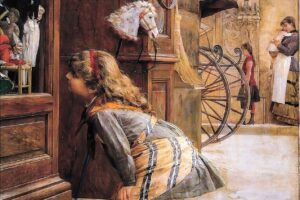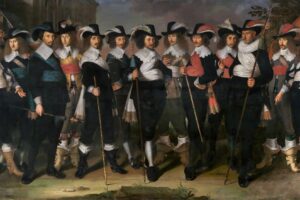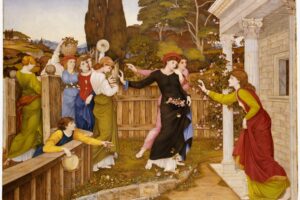Overview
Pia de’ Tolomei (c.1868) by Dante Gabriel Rossetti portrays the tragic heroine from Dante Alighieri’s Purgatorio, part of The Divine Comedy. The painting depicts Pia imprisoned in the Maremma marshes, betrayed by her husband, and left to die.
Rossetti, one of the founding members of the Pre-Raphaelite Brotherhood, transforms her suffering into visual poetry. Draped in luminous robes, surrounded by ivy and symbolic objects, Pia embodies both physical captivity and spiritual endurance. With melancholy beauty, Rossetti fuses literary inspiration with the Pre-Raphaelite devotion to symbolism, color, and emotion.
The Story Behind the Painting
Dante’s Source in Purgatorio
In Canto V of Purgatorio, Dante encounters Pia, who tells him:
“Remember me, who am Pia; Siena gave me life,
Maremma took it from me;
This he knows, who first espoused me with his ring.”
Her words suggest she was betrayed by her husband, Nello della Pietra, who confined her to the deadly swamps of Maremma. Her story became a Renaissance and Victorian symbol of wrongful suffering and female endurance.
Rossetti’s Fascination with Tragic Heroines
Rossetti frequently returned to figures of tragic women — Beata Beatrix, Proserpine, and others — whose beauty and melancholy reflected his own inner turmoil. Pia’s tale of betrayal, isolation, and spiritual endurance resonated deeply with him, especially during his later years when his own health and emotional life were troubled.
Commission and Creation
Rossetti painted several versions of Pia de’ Tolomei between 1866–1881. The version from c.1868 is among the most celebrated, embodying the Pre-Raphaelite blend of literary narrative, symbolism, and luminous color.
Composition and Subjects
Pia in Captivity
At the center sits Pia, draped in flowing silver-grey robes tinged with lilac. She leans wearily, hands entwined, her face pale with sorrow. Her posture suggests resignation, yet her expression holds quiet dignity.
Symbolic Surroundings
- Sundial: At her feet, a gilded sundial symbolizes the passage of time and her confinement.
- Prayer Book and Rosary: Open pages and black beads rest nearby, evoking devotion and faith as her only comfort.
- Birds in Flight: A flock of ravens or crows darkens the sky, harbingers of death and reminders of her fate.
- Ivy and Fig Leaves: The greenery growing around her suggests both entrapment and endurance, life persisting even in sorrow.
Distant Landscape
Behind her, red-roofed towers and a desolate landscape hint at Siena and the marshes of Maremma, tying her personal story to place and history.
Art Style and Techniques
Pre-Raphaelite Detail
Rossetti employs the Brotherhood’s hallmark precision — every leaf, bead, and thread rendered with clarity. The jewel-like palette glows, with silver, green, and deep crimson balancing melancholy with richness.
Symbolist Influence
Beyond realism, Rossetti layers symbolic meaning into each object: time, faith, death, and memory. Pia’s suffering is thus not only personal but allegorical, embodying universal themes of betrayal and endurance.
Portrait-like Intensity
As with many of Rossetti’s heroines, Pia bears the features of his models, possibly Jane Morris, whose melancholy beauty infused many of his later works. This portrait-like intensity blurs individual identity with allegorical meaning.
Legacy and Reflection
A Victorian Icon of Tragedy
Pia de’ Tolomei was deeply admired in the Victorian period as both literary illustration and symbolic art. It fit within Rossetti’s fascination with Dantean subjects while offering viewers a meditation on love, betrayal, and mortality.
Enduring Resonance
The painting remains one of Rossetti’s most haunting images. Pia’s silent endurance, surrounded by symbols of time, faith, and fate, continues to speak of the fragility of love and the weight of betrayal.
She sits in sorrow, hands entwined, ivy growing around her, while crows darken the sky. Time passes, faith sustains, and betrayal lingers. In Pia de’ Tolomei, Rossetti transforms a brief Dantean line into an eternal vision of beauty, tragedy, and endurance.



